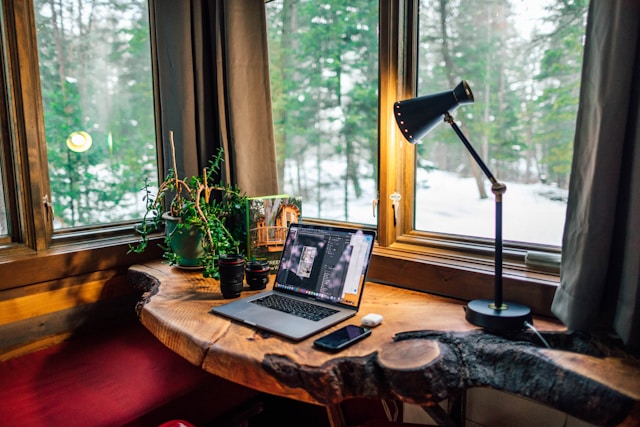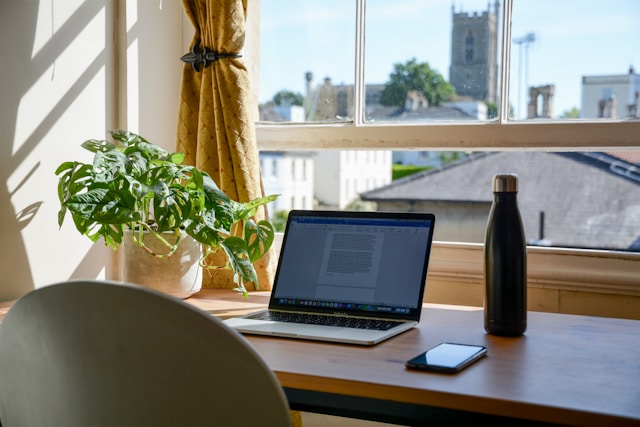Table of Contents
After a move, setting up a new space offers a rare chance. You can build with intention from the start. If you’re working from home now, it’s time to design a sustainable home office that supports your focus and aligns with your values. Creating a green space can lower your bills, reduce waste, and improve your health. Start small and stay consistent. Each mindful choice brings you closer to your goal. This guide helps you achieve a more sustainable lifestyle without compromising comfort or functionality.
How Can You Design a Sustainable Home Office with Minimal Impact?
More people than ever now work from home—about 27% of U.S. employees, according to a 2023 report by WFH Research. While remote work can enhance flexibility and alleviate commuting stress, it can also blur the distinction between personal and professional life. That shift affects mental health, sometimes in ways we don’t expect. A well-designed home office can enhance focus, reduce anxiety, and even promote long-term well-being. But it needs to be intentional, practical, and environmentally conscious. Here’s how you can build that kind of space step by step:
- Choose the right spot inside your home
- Use what you have before you buy
- Pick earth-friendly materials that last
- Choose devices that save energy
- Reduce paper waste and go digital
- Creating a comfortable and healthy environment
- Improve air quality with simple choices
- Maximizes daylight and uses less power
- Organize your office with the planet in mind

Choose the Right Spot Inside Your Home
Before buying anything, look around. A smart location saves energy and increases comfort. Choose a room that gets natural light. Sunlight boosts mood and cuts your lighting needs. A window that opens allows fresh air to circulate, reducing your need for air purifiers.
Next, think about noise. If you’re near the street or kitchen, use thick rugs and soft furniture to absorb sound. Avoid rooms that get too hot or too cold. This step reduces your need for heating or cooling.
Use What You Have Before You Buy
Buying all-new furniture can feel like an easy choice, especially after a big move. But before you start shopping, take a closer look at what you already own. A dining chair can be a suitable choice for a home office. A sturdy old bookshelf might be the perfect fit for your files. When relocating your home office, reusing familiar pieces often saves more than just money—it reduces waste and makes your setup feel more personal and inviting.
Some people hesitate to bring furniture during international moving because of shipping costs or logistics. That concern is valid, but whenever possible, keeping what you have is the more sustainable option. Moving solid, well-made pieces usually creates less environmental impact than replacing them with fast-made, new items.
Here are great places to find second-hand additions if you still need a few extras:
- Local “buy nothing” groups
- Online marketplaces like Craigslist or Facebook Marketplace
- Charity-run thrift stores with furniture sections
- Flea markets that feature upcycled office items
Older furniture often lasts longer than new mass-produced alternatives—and it adds character to your workspace, too.
Pick Earth-Friendly Materials That Last
When shopping, watch for certain labels. Look for FSC-certified wood, which comes from responsibly managed forests. Select desks or chairs crafted from bamboo, recycled metal, or salvaged wood.
Painting and finish also matter. Choose low-VOC or no-VOC paint to minimize exposure to harmful fumes. This protects both your health and the indoor air quality.
Textiles and soft items, such as cushions or curtains, should also be made from natural fibers like cotton or hemp. Avoid plastic blends or synthetics when possible.
Choose Devices That Save Energy
Every plug counts. Computers, lamps, printers—all use power even when idle. Use Energy Star-rated equipment to reduce wasted energy. Additionally, consider using smart plugs or power strips that automatically shut off at night.
Consider using LED lighting instead of traditional bulbs. These last longer and use less power. A desk lamp with a dimmer switch allows you to adjust the brightness and save power with minimal effort.
If your new house has solar panels, plug in your office gear during daylight hours. That keeps your setup lean, smart, and green.
Reduce Paper Waste and Go Digital
A lot of office waste comes from paper. Now is the right time to create better habits. Digital files occupy no space and require no paper. Sign documents electronically. Use cloud storage instead of print copies. When you must print, use both sides of the page. Buy recycled paper and set your printer to draft mode to save ink. Place a small recycling bin near your desk to remind you to sort your waste properly. To design a sustainable home office, start with less, think longer-term, and stay flexible as your needs grow. Small, smart shifts add up.

Create a Comfortable and Healthy Environment
You spend hours inside your office. That space must support both your body and your focus. An ergonomic chair can reduce back pain. A desk at elbow height helps maintain strong posture. Select seating made from recycled materials or sustainably harvested wood.
For softness underfoot, choose natural-fiber rugs. Avoid synthetic ones that release microplastics. Cotton, jute, or wool are better choices. They add texture and trap dust. Also, avoid chemical-heavy air fresheners. Use essential oils, beeswax candles, or natural sprays instead.
Indoor plants help clean the air. Snake plants, pothos, and peace lilies are all suitable for indoor growth. Their leaves absorb toxins. Their green color brings calm. You don’t need a lot—just a few well-placed pots can make the space feel both alive and productive.
Improve Air Quality with Simple Choices
Fresh air matters. Open windows often. That helps reduce indoor pollutants. Use fans to circulate air instead of turning on the air conditioner. In cooler months, crack a window open, even for ten minutes a day.
Paint, finishes, and new furniture can release harmful chemicals. Choose items marked “low-VOC” or “no-VOC.” These versions reduce the chemicals in your space. Look for natural alternatives in curtains, pillows, and carpets. To reduce dust, keep your surfaces clean and clear of debris—clutter traps dirt. A cleaner desk helps your lungs and your workflow.
Maximize Daylight and Use Less Power
Place your desk near a window. Let the daylight do the work. It lifts your mood and sharpens your focus. It also means you don’t need to switch on the lights until evening.
Use mirrors or glossy surfaces to bounce light across the room. Select sheer curtains that soften the glare while allowing natural light to pass through.
Then, when you need extra light, choose LEDs. Set timers to turn off the lights automatically at night. Smart switches give you control. This is one easy way to try energy-efficient electrical solutions without rewiring your entire house.
Organize Your Office with the Planet in Mind
Keep your layout simple. Limit purchases to what you use daily. Instead of plastic bins, store items in wooden crates or cloth baskets. Look for recycled cardboard organizers for paperwork or supplies.
Declutter regularly. Donate your unused gear to local schools or charities. Resell gently used tech online. Don’t toss useful things—give them new homes.
If you downsized recently, keep that energy alive. Take a moment to reassess what truly matters in your office. This supports sustainable downsizing as a lifestyle, not just a one-time act.

Build the Office That Reflects You!
You’ve just moved. You now have control over how your home office looks, functions, and feels. This is the perfect opportunity to design a sustainable home office that conserves resources and boosts your energy. Choose better. Act with care. Keep refining your space. A few strong choices today create a lasting impact for tomorrow.
